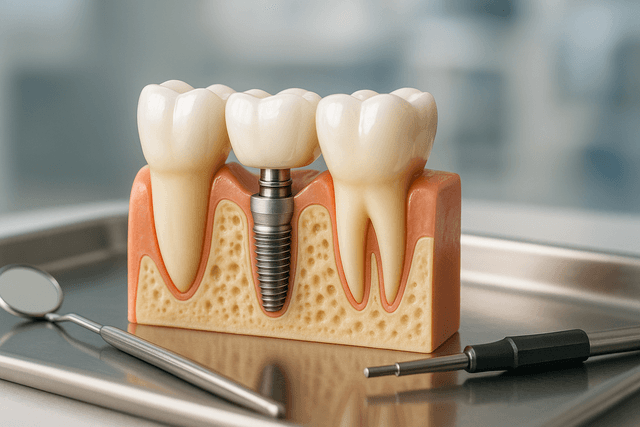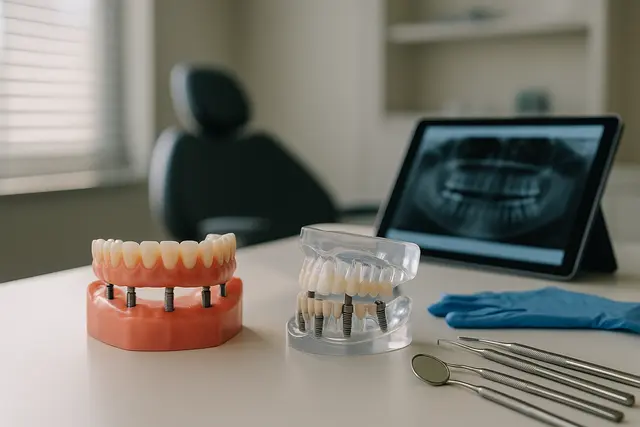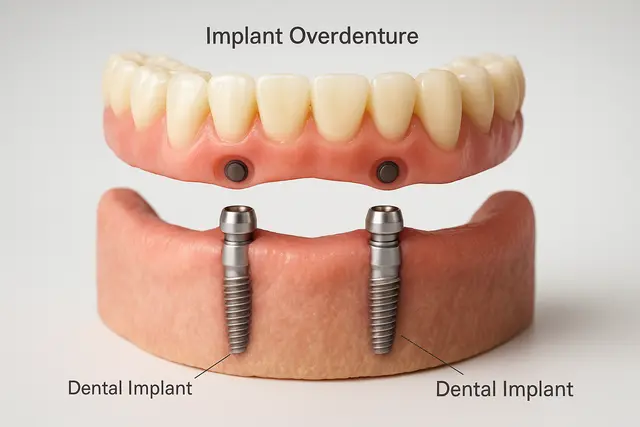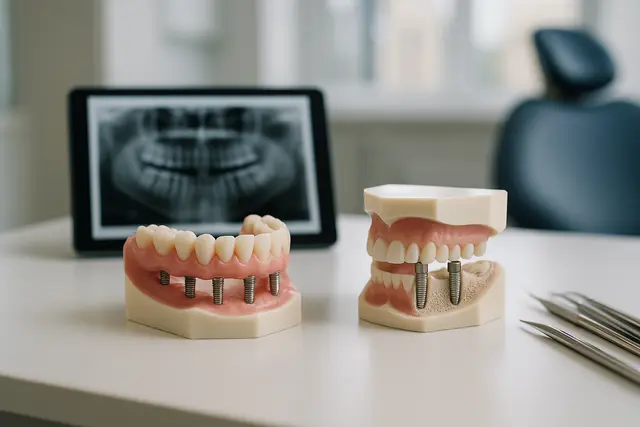Prosthodontics
4 min read
Oct 10, 2025
Implant Retained Bridge Durability and Care: A Guide to Lasting Performance
Missing multiple teeth can affect more than just your appearance, it can impact your confidence, speech, and ability to enjoy your favorite foods. Among the many restorative options available, implant-retained bridges stand out for their strength, stability, and longevity. This guide explores what makes them durable and how to care for them properly to get the most from your investment.

If you’re missing teeth, you’ve probably explored every option under the sun, removable dentures, traditional bridges, or maybe even just pretending it’s not a problem (we’ve all been there). But if you’re looking for something strong, natural-looking, and built to last, an implant retained bridge could be your smile’s new best friend.
Let’s break down what makes these bridges tough, how to care for them like a pro, and why the right dental work can mean a lifetime of confident chewing, laughing, and living.
Bridge Strength Starts with Dental Implants
Unlike a traditional bridge that relies on your natural teeth for support, an implant-supported bridge is anchored by dental implants placed in your jawbone. These implant posts act as artificial roots, giving the bridge unmatched stability and durability. It’s not just about looking good (although it does that, too); it’s about restoring real function.
The implant fuses with your bone through a process called osseointegration, creating a rock-solid foundation for the bridge. This setup makes it ideal when you're replacing multiple missing teeth, especially when you're after a long-term solution that doesn’t mess with your healthy teeth.
Why Implant-Retained Bridge Durability Outperforms the Rest
The durability of an implant bridge doesn’t just come from the metal and porcelain. It comes from smart planning, skilled implant placement, and high-quality materials. A bridge is supported by implants, not natural teeth, so it avoids common issues like enamel wear or decay under the bridge.
A custom bridge designed by an experienced dental professional ensures the fit is just right, reducing stress on the surrounding teeth and bone. When done well, an implant-supported bridge can last for many years, some even enjoy a lifetime with proper care.
Daily Dental Care Keeps Your Bridge Going Strong
Here’s the thing: even the most advanced dental restoration won’t survive neglect. To make your bridge last, daily care is crucial. That means brushing at least twice a day with a soft-bristled toothbrush and using floss or special tools for cleaning under the bridge.
Plaque and food particles can build up around the implant site and underneath the bridge. If left unchecked, this can lead to gum disease, inflammation around the implant, and even implant failure. Yep, you read that right. The risk of implant failure jumps without good oral hygiene.
So, let’s keep it simple. Brush every day with a soft-bristled toothbrush. Floss around the bridge, especially near the gum line and around the implant. Water flossers and interdental brushes can be a game-changer for cleaning under the bridge effectively.
Oral Health and the Role of Regular Dental Visits
Think of your dentist like your bridge’s pit crew. Regular dental check-ups and cleanings help ensure your bridge is performing at its best. During these visits, your dental team checks for any signs of wear, plaque buildup, or gum issues around the implant.
Skipping these appointments? Not a great idea. They’re your best defense against small problems turning into big ones. Routine dental care also helps maintain your overall oral health, which directly affects how long your bridge lasts.
Types of Dental Bridges and Why Implant Retained Bridges Win
When it comes to replacing teeth, there’s no one-size-fits-all solution. Fixed bridges, traditional bridges, and implant-supported bridges each have their place. But if you need to replace multiple missing teeth, implant-supported bridges are hard to beat.
A traditional bridge typically relies on teeth for support, which means grinding down perfectly healthy ones. That might work short-term, but long-term it can weaken those teeth. Implant bridges, on the other hand, skip that risk entirely. They're attached to dental implants, so your natural teeth stay untouched.
Fixed bridges are also an option, but they may not offer the same level of stability and longevity. With the right care and maintenance, dental bridges can last over a decade, but implant-supported bridges can outpace them significantly.
Longevity Comes Down to Care and Maintenance
Let’s talk numbers. So, how long can your implant-supported bridge last? With proper care and maintenance, an implant-supported bridge can last 15 years or more. Some even hit the 25+ year mark. But there’s a catch, how well you take care of it matters.
Neglecting oral hygiene, skipping regular dental check-ups, or smoking can all increase the risk of implant failure. On the flip side, following these care and maintenance tips can ensure your bridge provides reliable performance and helps maintain the health of your teeth and gums.
Make a habit of:
Brushing twice a day with a soft-bristled toothbrush
Flossing around the implant and bridge daily
Cleaning under the bridge using floss threaders or water flossers
Scheduling regular dental check-ups and cleanings
Avoiding hard or sticky foods that can damage the bridge
It’s a routine that pays off by helping your bridge last and protecting your overall dental health.
Family Dental Support Makes a Big Difference
Having a go-to family dental team makes keeping up with care easier. They’ll help monitor changes around the implant, ensure the bridge is still fitting right, and guide you if anything needs adjusting. Plus, it’s just nice having a team that knows your mouth better than you do.
If you’re working with an office experienced in implant dentistry, they’ll help you get the most from your dental investment, whether it’s your first implant bridge or part of a bigger restoration plan.
What Makes an Implant-Retained Bridge More Durable Than a Traditional Bridge?
An implant-retained bridge is anchored directly to the jawbone using dental implants, rather than relying on adjacent natural teeth for support. This setup provides exceptional stability and bite strength while preventing jawbone shrinkage, a common issue after tooth loss. Because the implants act like natural tooth roots, they help maintain bone density and gum health, making them far more durable than traditional bridges.
How Long Does an Implant-Supported Bridge Typically Last?
With proper oral care and routine dental visits, an implant-supported bridge can last 10 to 15 years or even longer. The implants themselves may last a lifetime if osseointegration (the bond between the implant and bone) remains strong. The bridge restoration on top may eventually need replacement due to normal wear, but longevity largely depends on oral hygiene habits, diet, and overall health.
What Is the Best Way to Care for an Implant-Retained Bridge?
Caring for an implant-retained bridge is similar to caring for natural teeth, but with extra attention to cleaning under the bridge. Brush twice daily with a soft-bristled toothbrush, and use tools like a floss threader, super floss, or a water flosser to clean beneath the bridge. Avoid hard or sticky foods that could stress the implants, and visit your dentist every six months for professional cleanings and evaluations.
What Are Warning Signs of Implant Bridge Problems?
Early warning signs include redness, swelling, persistent bad breath, or a bridge that feels loose when you bite. These could indicate gum inflammation, peri-implantitis (infection around the implant), or potential implant failure. Addressing these symptoms early allows your dentist to correct the issue before it progresses, protecting both your implants and the surrounding bone structure.
Read Next
Related Posts

Prosthodontics
Implant Supported Dentures Overview
Missing teeth can impact more than just your smile, they can affect your confidence, comfort, and even your diet. Fortunately, modern dentistry offers a solution that’s both secure and natural-looking: implant-supported dentures. This innovative approach blends the stability of implants with the convenience of dentures to create a long-lasting, life-improving upgrade.
5 min read
Oct 29, 2025

Prosthodontics
Implant Overdentures Explained: The Hybrid Solution to Missing Teeth
Missing teeth can impact everything from your ability to eat to your self-confidence. While traditional dentures have long been a go-to solution, they often fall short in comfort and stability. Implant overdentures offer a modern alternative that combines the security of dental implants with the convenience of removable dentures, a true upgrade for those looking to reclaim their smile.
6 min read
Oct 29, 2025

Prosthodontics
Implant Retained Dentures Explained
Considering implant-retained dentures? You're not alone. As modern dentistry evolves, more people are turning to this secure, natural-feeling alternative to traditional dentures. This guide will walk you through what they are, how they work, and why they might be the solution you've been looking for.
4 min read
Oct 28, 2025
Don’t have time to research every dentist around you?
See why 30k+ patients trusted us